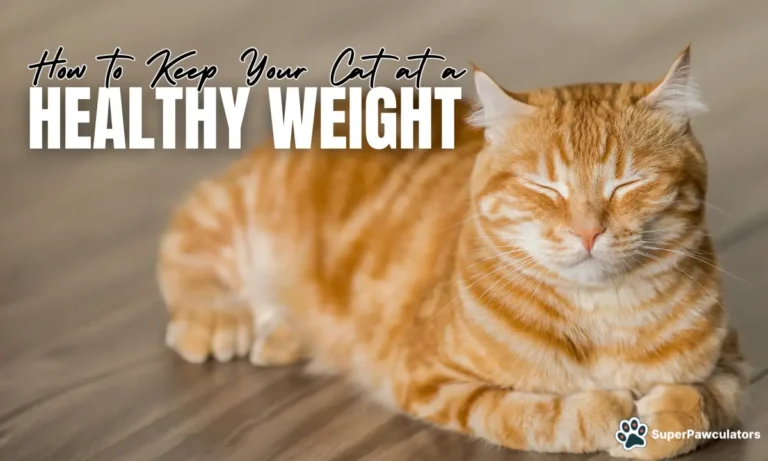To help us create more feline tools and guides, this site contains affiliate links, which may earn us a small commission at no extra cost to you.
As a cat owner, ensuring your furry friend maintains a healthy weight is one of the best ways to keep them happy and thriving. Weight management is crucial, not just for aesthetic reasons but to prevent serious health issues that can affect your cat’s quality of life.
Here’s why you should pay attention to your cat’s weight:
- Health Risks of Obesity: Extra pounds can lead to chronic conditions such as diabetes, arthritis, and heart disease.
- Dangers of Being Underweight: Cats that are too thin may suffer from malnutrition, weakened immunity, and other health problems.
Achieving a balanced weight is easier than you think with the right tools and guidance. For example:
- Use our Cat Weight Calculator to identify your cat’s ideal weight based on their age, breed, and activity level.
- Pair this with the Cat Exercise Calculator to plan daily activities tailored to your cat’s needs.
Throughout this guide, you’ll find actionable tips to manage your cat’s weight, prevent obesity, and encourage a healthier lifestyle. Whether your cat needs to shed a few pounds or gain some, this article has you covered.
How to Assess Your Cat’s Current Weight
Understanding your cat’s current weight and overall body condition is the first step toward effective weight management. Here’s how you can evaluate your cat’s health and identify whether they’re in the ideal weight range:
- Visual Inspection:
- Look for a visible waist when viewing your cat from above. A healthy cat should have a slight inward curve near the abdomen.
- Observe their belly from the side. A sagging belly or no visible tuck could indicate overweight, while a sharply tucked-in abdomen might mean they’re underweight.
- Tactile Check:
- Run your hands gently along your cat’s ribs. You should feel their ribs without pressing too hard, but they shouldn’t be overly prominent.
- Check their spine and hips; bones should not protrude or feel overly padded.
- Body Condition Scoring (BCS):
- Cats are often evaluated on a scale from 1 to 9:
- 1-3: Underweight.
- 4-5: Ideal weight.
- 6-9: Overweight to obese.
- Cats are often evaluated on a scale from 1 to 9:
- Consult Your Veterinarian:
- If you’re unsure about your findings, a vet can provide a thorough evaluation and suggest a tailored health plan.
Assessing your cat’s weight regularly ensures you catch potential health issues early. Combine these methods with professional guidance to stay proactive about your cat’s well-being.
Steps to Prevent Cat Obesity
Preventing obesity in cats requires a combination of mindful feeding practices, regular exercise, and consistent monitoring. By implementing these steps, you can keep your cat at a healthy weight and avoid obesity-related health issues:
Feeding Practices for Optimal Weight
- Portion Control: Follow the feeding guidelines on your cat food packaging and adjust portions based on your cat’s activity level and age.
- High-Quality Food Choices:
- Opt for high-protein, low-carbohydrate diets to maintain muscle mass and energy levels.
- Choose balanced formulas that include essential nutrients like taurine and omega-3 fatty acids.
- Avoid Free-Feeding:
- Set specific mealtimes instead of leaving food out all day. This prevents overeating.
- Use slow-feeder bowls to help cats eat at a more measured pace.
Treats in Moderation
- Treats should account for no more than 10% of your cat’s daily caloric intake.
- Opt for low-calorie treats or natural options like small pieces of cooked chicken.
- Avoid giving human food, which may be high in fat or toxic to cats.
Regular Monitoring
- Track your cat’s weight using tools like the Cat Weight Calculator.
- Observe changes in their body shape and energy levels over time.
By adopting these feeding habits, you’ll set the foundation for a healthy lifestyle and ensure your cat maintains a balanced weight. Pair these tips with exercise, which we’ll explore in the next section, to create a holistic approach to weight management.
Encouraging Physical Activity
Regular exercise is vital for maintaining a healthy weight and keeping your cat mentally and physically stimulated. Cats are natural hunters, and incorporating activities that mimic their instincts can make exercise enjoyable and effective.
Daily Exercise Routines
- Aim for 15–30 minutes of active play daily to burn calories and keep muscles strong.
- Break exercise into short sessions to match your cat’s natural energy bursts.
Interactive Toys and Games
- Use toys like feather wands, laser pointers, and motorized mice to engage your cat in chase-and-pounce activities.
- Rotate toys regularly to keep your cat interested and curious.
Climbing Structures and Scratching Posts
- Provide cat trees, shelves, or perches to encourage climbing and jumping.
- Scratching posts not only keep claws healthy but also offer a form of stretching exercise.
Create Engaging Environments
- Hide small treats or kibble around the house to turn mealtime into a scavenger hunt.
- Use puzzle feeders to combine mental stimulation with physical activity.
Tailor Activities Using Tools
- The Cat Exercise Calculator is a great resource for planning customized routines based on your cat’s age and activity level.
Social Play
- If you have more than one cat, supervised playtime can encourage them to chase, wrestle, and interact, naturally boosting activity levels.
By incorporating these strategies, you can make exercise a fun part of your cat’s daily routine, contributing to their overall health and weight management.
Tools for Monitoring and Managing Cat Health
Effectively managing your cat’s weight and overall health is easier with the right tools and resources. These tools provide valuable insights into your cat’s well-being and help you stay proactive in preventing weight-related issues.
Weight Monitoring Tools
- Track your cat’s weight over time and compare it against the ideal range for their breed, age, and activity level.
- Regular weighing:
- Use a pet scale or weigh yourself holding your cat and subtract your weight for an approximate measure.
Exercise Planning
- Plan personalized exercise routines that align with your cat’s fitness needs and energy levels.
- Track daily activity with smart wearables or fitness apps designed for pets.
Nutritional Apps and Smart Feeders
- Mobile apps can help you log meals, treats, and hydration levels to ensure balanced nutrition.
- Smart feeders allow precise portion control and scheduled feeding, which helps prevent overfeeding.
Regular Veterinary Visits
- Schedule check-ups at least once a year to monitor your cat’s weight and overall health.
- Discuss any concerns with your vet, including diet adjustments and specialized feeding plans.
Behavioral Observation
- Watch for changes in appetite, activity, or mood, which could indicate health issues.
- Record observations to share with your vet during visits.
Using these tools and resources ensures that you’re taking a comprehensive approach to your cat’s weight management. Together, they help create a structured plan for long-term health and happiness.
A Healthy Cat is a Happy Cat
Maintaining your cat’s healthy weight is one of the most impactful ways to ensure they live a long, happy life. By focusing on a balanced approach that includes proper nutrition, regular exercise, and consistent monitoring, you can prevent obesity and other weight-related health issues.
Here’s a quick recap of the key steps:
- Understand your cat’s ideal weight and assess their current condition.
- Prevent obesity by managing portion sizes, choosing the right foods, and avoiding excessive treats.
- Encourage physical activity daily, with interactive toys, climbing structures, and planned routines.
- Leverage modern tools like apps and smart feeders to streamline your weight management efforts.
- Schedule regular veterinary visits and remain observant for any changes in your cat’s behavior or health.
By implementing these strategies, you’re not just managing weight, you’re investing in your cat’s quality of life. A proactive approach to health and fitness ensures your feline companion will stay energetic, playful, and content for years to come.
Take the first step today with the tools and tips shared in this guide, and give your cat the gift of optimal health!

